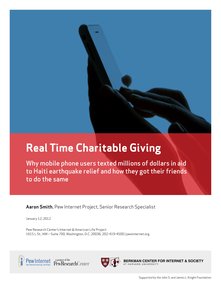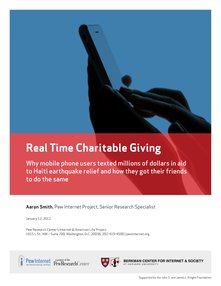
The new mobile giver and the story behind millions in donations by text for Haiti
A new kind of charitable giver is emerging in the mobile age.
A report underwritten by the John S. and James L. Knight Foundation has found that this donor is younger and more likely to be African-American or Latino than traditional donors. Moreover, new donors often use their mobile phones to make contributions through text messaging that is inspired by moving and sometimes distressing stories about people in crisis.
These findings have important implications for non-profits and philanthropies that depend on fundraising and the report particularly highlights how text giving is a spontaneous act, done on the spur of the moment and without a lot of background research on the organization to which the contribution is being made.
These insights emerge in a report by the Pew Research Center’s Internet & American Life Project and Harvard’s Berkman Center for the Internet & Society. They are contained in Pew Internet surveys that probed two things: First, there was a special survey of the donors who gave text-based contributions just after the devastating earthquake in Haiti that hit the island exactly two years ago today. The donor list for that survey came from the mGive Foundation, which provides technology for charities to facilitate text giving. Second, there was a national survey aimed at understanding the nature of the broader population of text-contributors.
The full Pew Internet-Berkman report can be found at pewinternet.org/mobilegiving.
Knight Foundation supported this work because it is interested in helping non-profits and foundations of all kind find new ways to serve their communities and constituencies. Its starting point was the insight that technology is increasingly relevant to Americans’ monetary contributions to the causes and organizations they support. For instance, many were startled by the size of the contribution effort in Haiti as individual donors contributed an estimated $43 million to the assistance and reconstruction efforts using the text messaging feature on their cell phones.
What the surveys showed
The national phone survey is the one that produced findings about the new demographics of mobile givers. Compared to previous work by Pew Internet about more traditional charitable contributors, these mobile givers are younger and more racially and ethnically diverse. This might partly be the case because young adults and minorities are especially attached to their mobile phones. They are more likely to own them, exchange text messages and perform a variety of other activities on them like accessing the internet and sharing photos and videos.
The special sample of Haiti text givers was a representative sample drawn from more than 550,000 contributors to the “Text for Haiti” campaign who gave permission for follow-up contact with them. This survey was the first major in-depth exploration of this special population. Overall, 863 interviews with these donors produced some striking findings that show how disruptive mobile giving has become in the charitable-giving landscape:
· The ability to send small donations using mobile phones facilitates “impulse giving” in response to moving images or events.
· The typical Haiti text donor in our survey was a first-time mobile giver who made a single contribution to earthquake relief using his or her mobile phone.
· A majority of the Haiti text donors in our sample have contributed to more recent disaster recovery efforts using their phones such as the Japanese earthquake and tsunami, the Gulf of Mexico oil spill, and the tornado disasters in the U.S. last spring and summer.
· Charitable giving in the mobile age by these donors is a social networking activity, but more through in-person conversations than through online tools. Many of the givers convinced family members and friends to give donations for Haiti disaster relief.
· These mobile givers are willing to make donations in a number of ways—but prefer not to do so by making a phone call.
· The Haiti text donors in this survey are similar to Americans as a whole when it comes to participation in social or civic groups and engagement with news, but differ when it comes to technology ownership.
In this survey we looked at several dimensions of the lives of these givers. They stand apart from other Americans in that they have more technology in their lives, but their civic profile and their engagement with news mirrors the general population. They are not necessarily major donors in general, though almost all give at least something to other charities.
When compared with Americans as a whole, the Haiti text givers we surveyed are no more or less involved with charitable or non-profit groups—they are slightly more likely than average to belong to a community group or neighborhood association, but have similar levels of involvement with a range of other groups such as charitable or volunteer organizations, political parties and environment groups. They also follow local, national and international news almost exactly as closely as the national average.
However, these donors are different when it comes to their technology habits, and are significantly more likely than U.S. adults as a whole to:
· Own an e-reader (24% do so, compared with 9% of all US adults), laptop computer (82% vs. 57%) or tablet computer (23% vs. 10%).
· Use Twitter (23% of the Haiti donors we surveyed who go online are Twitter users, compared with 12% of all online adults) or social networking sites (83% vs. 64%).
· Use their phones for activities such as accessing the internet (74% do so, compared with 44% of all adult cell owners), taking pictures (96% vs. 73%), recording video (67% vs. 34%) or using email (70% vs. 38%).
Robert Faris, head of research at the Berkman Center, noted that the Haiti disaster contributors combined both traditional givers who are civically active plus the new cohort of younger, more racially and ethnically diverse populations who do not match the standard profile of traditional givers. This could be a hallmark of future giving, particularly in moments where global attention is focused on a disaster or crisis.
“We could be seeing some dramatic shifts in the contours of giving thanks to smartphones and tablet computers,” added Aaron Smith, the Pew Internet researcher who wrote the report. “Cell phones are the fastest spreading and most ubiquitous tech devices the world has ever seen. There is reason to suspect that givers in other countries might eventually look like the ones we explored here. The implications of that for foundations and non-profits are pretty profound.”
Recent Content
-
Community Impactarticle ·
-
Community Impactarticle ·
-
Community Impactarticle ·



